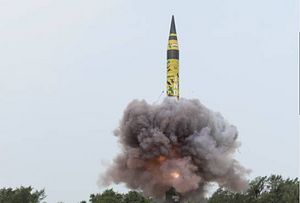Indian Nuclear Policy. 2018. Oxford University Press. By Harsh Pant and Yogesh Joshi.
May 2018 marked the twentieth anniversary of India’s breakout as an overt nuclear state. That was the month Indian when, across two nonconsecutive days, India detonated five weaponized nuclear devices. It ended an elongated period of India fielding an effective “recessed deterrent”—an untested, but virtually complete nuclear capability. But India’s story as a nuclear state didn’t begin in 1998 and new chapters continue to be written today.
Many authors—Indian and non-Indian—have told parts of the story of India’s emergence as a nuclear weapons state, but none have done so as concisely and completely as Harsh Pant and Yogesh Joshi. (Disclosure: Harsh Pant contributes a column here at The Diplomat.) The authors—a security scholar and historian, respectively—have published a five-chapter, 165-page, pocket-sized account of India’s nuclear policy as part of Oxford University Press’s “India Short Introductions” series. The result is an eminently readable crystallization of India’s nuclear story.
Technical readers and nuclear wonks might look elsewhere. This is a book about history, leadership, politics, policy, doctrine, and, in certain circumstances, capabilities. It is not an attempt to tell the techno-military history of India’s race to the bomb and its development of various nuclear weapon delivery vehicles—and it does not attempt to do so. Given the author’s particular areas of expertise and interest, some of the technical content is better presented than others; for instance, Joshi’s work on the history of India’s indigenous nuclear ballistic missile submarine project is aptly reflected in their discussion of the Arihant-class ballistic missile submarine.
Where Pant and Joshi succeed is in having produced what is, as of late-2018, the most succinct and complete account of the origin, development, and present state of Indian nuclear policy. For a reader with a passing interest in the subject but unfamiliar with the early Cold War origins of Indian thinking on nuclear weapons, for instance, this book will be invaluable. Similarly, the book serves a helpful resource for nuclear specialists that may be transitioning to more serious work on India, providing a distillation of what can be termed the Indian ’nuclear psyche’.
Here, Pant and Joshi recount India’s historical misgivings with a global nonproliferation regime that it has long perceived—and still continues to perceive—to be fundamentally discriminatory and unfair. Even while the Indian view of the institutions that undergird the global nonproliferation regime—chief among them the Nonproliferation Treaty (NPT)—may not find wide acceptance, understanding New Delhi’s perspective on this topic is central to understanding much of the basis of India’s post-1998 maneuver as a de facto nuclear weapon state.
The core theme of the book, highlighted on the jacket, is the remarkable story of just how successful India has been in transforming itself from a “nuclear pariah” that faced sanctions for its breakout in 1998 to a virtual member of the global nuclear community, lacking in formal institutional trappings, but largely unseen as a ”problem.” Pant and Joshi rightly underline India’s accommodation as a success story for New Delhi’s quest for security and status.
The story of India’s nuclear policy as presented in complete, ranging from the CANDU reactor to Homi Bhabha’s plutonium reprocessing efforts to the Indian reaction to China’s 1964 breakout, two years after India’s humiliating defeat at Mao Zedong’s hands in the 1962 war. It recounts Pakistan’s vivisection at India’s hands in the 1971 war and Islamabad’s reinforced resolve to pursue the bomb. (Pakistan is a supporting cast member across the book, by necessity, but Pant and Joshi largely steer clear of explaining Pakistani decision-making.)
From there, Pant and Joshi reconstruct the era of the Indo-Pakistani “recessed” deterrent relationship, from the late-1980s all the way to 1998s. The post-1998 history focuses primarily on India’s efforts to find and finesse its doctrine, seek accommodation in the international system, and tailor its deterrent to meet the twin challenges emanating from China and Pakistan. While the authors offer a brief account of ongoing debates in India on force structure and doctrine, it is not a focus, with the exception of the debate around India’s attempts to find a workable posture to Pakistan’s post-1998 force structure changes to favor low-yield nuclear weapons designed for battlefield use. One wishes that they had included a sixth, forward-looking chapter on the next twenty years of India’s existence as a nuclear weapons state and its search for security and status.
India isn’t likely to fundamentally rethink the role of nuclear weapons in its national policy toolkit, nor are dramatic force structure changes likely due to a range of factors, bureaucratic inertia and resource constraints among them. But nuclear weapons will always matter for India’s security given its two nuclear-armed neighbors. How New Delhi manages the twin challenges of successfully sustaining deterrence against Pakistan and China—at the conventional and sub-conventional level in the former’s case—while managing its bespoke “responsible” non-NPT nuclear power status will remain relevant questions.

































